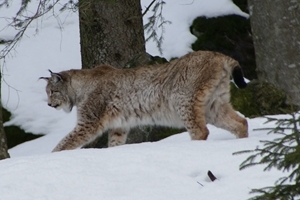Eurasian lynx
 Here we are, another year has passed and another one has begun, and my goodness last year shot by! But the Christmas break gave me time to slow down and spend time with family and friends, doing mad things like swimming in the sea on New Year’s Day with friends from the GWCT and taking my little daughter out to the local (native/European) wildlife park, which has inspired me for this month’s Species of the Month.
Here we are, another year has passed and another one has begun, and my goodness last year shot by! But the Christmas break gave me time to slow down and spend time with family and friends, doing mad things like swimming in the sea on New Year’s Day with friends from the GWCT and taking my little daughter out to the local (native/European) wildlife park, which has inspired me for this month’s Species of the Month.
As we walked around the deserted wildlife park on a very rainy New Year’s Eve, we had a chance to see lots of the animals that normally would be shying away at the back of the enclosure due to large crowds of noisy visitors, but as no one else was mad enough to get their waterproofs on and brave the weather like us, we had lots of close encounters. One in particular that has really stuck in my mind is seeing a Eurasian lynx (Lynx lynx) for the first time. As we walked silently – which, with a toddler, is a miracle in itself – up to the large enclosure, we saw one dash across the front of the fence. As we walked closer, we came face-to-face with a lynx, which was slowly settling and silently watching us about halfway into the enclosure. Although this wasn’t a chance sighting in the wild, it still was quite exciting seeing this ghost-like cat, pale against the brown background, remaining motionless watching us with great intent. Maybe it was working out if my daughter, about the size of a small roe deer, would be fair game!
So, what does it look like? Its coat is long and very dense, especially during the winter when it is yellowish-grey, silver-grey, grizzled greyish-brown, dark grey, or ashy blue in colour, with a shorter summer coat, which is more brownish or reddish. The pattern on the coat varies a lot, with some animals having very clear black spots, which sometimes become narrow stripes, others having almost no spots. They have a distinctive ruff of long hairs framing the face, with large, pointed ears tipped with 4-5cm erect tufts of dark hair. Their legs are long, with rear limbs longer than the front ones, giving body a tilted forward look, and their footpads are broad and well furred for walking on snow. The short tail is black-tipped.
The Eurasian lynx is the largest lynx species (there are four – Canada, Iberian, Eurasian and bobcat) and is the third largest predator in Europe after the brown bear and the wolf, ranging from 80cm to 130cm in length, weighing 15-28kg, and standing 60cm in height. It has one of the widest ranges of all cat species, extending across northern, central and eastern Europe, central Asia (it is distributed across the entire Tibetan plateau), Siberia and east Asia, but it has been extinct in the United Kingdom for around 1,300 years due to a combination of hunting and habitat loss. It inhabits temperate and boreal forests up to an elevation of 5,500m (18,000ft) and throughout the northern steppes of the Himalayas.
Despite its wide distribution, it is threatened by habitat loss due to urbanisation of western Europe, deforestation, persecution, fragmentation, poaching and depletion of prey. However, over the past 50 to 80 years, autochthonous populations of Eurasian lynx have made an impressive recovery in northern Europe, in the Carpathians and in north-east Europe, west of Russia, contributing to the tenfold population increase during that period, with an estimated population of 30,000-50,000 animals in Russia and an estimated Mongolian population of about 10,000. Their population in central and southern Europe is estimated at 8,000 but is small and fragmented.
As the largest lynx species, they prey on wild ungulates (hoofed animals) like roe deer but will eat smaller animals when deer are scarce, including rabbits, hares, foxes, wildcats, squirrel, pine marten, domestic pets, sheep, goats and reared gamebirds. The proportion of their diet made up of this alternative prey is generally very small.
Although they may hunt during the day when food is scarce, the Eurasian lynx is mainly nocturnal or crepuscular (active at dawn and dusk) – their periods of hunting activity mirroring their prey’s behaviour, for example hunting deer at dawn and dusk – and they spend the day sleeping in dense thickets or other places of concealment. Like all lynx species, Eurasian lynx are solitary, secretive animals seldom witnessed by humans.
It is thought that lynx is not dangerous to humans, so maybe while you are out in the wilderness you might stumble across this solitary, beautiful species, or at a wildlife park like me.
Megan Lock
Advisory
Photo credit: Aconcagua